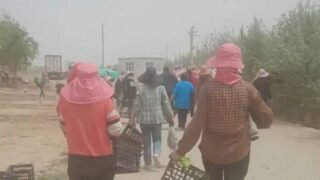Italy becomes the 22nd country to acknowledge the genocidal nature of Stalin’s artificial famine, which the Putin regime stubbornly continues to deny.
by Marco Respinti


It took a bloody war in the heart of Europe to realize that the capital of Ukraine is not “Kiev”—a war of blatant aggression perpetrated by a tyrant displaying neo-post-national-bolshevik trends and blessed by a Christian Patriarch who managed to make Christians ashamed of the very name “Christian.” “Kiev,” “Киев,” is Russian—not Ukrainian. In Ukrainian, the capital of Ukraine is Kyiv, “Київ.” Widely used as it was, “Kiev” was the result of Russia’s attempt to distort the nature of Ukraine. “Kiev” is the fruit of Russian imperialism, nationalism, and chauvinism. Using “Kiev” is part of the Russification of Ukraine, imposed by Soviet national-communism not only on Ukrainians, but on the entire world, on collective memory, and on the sense of history. “Kiev” is the mark of the Soviet ideology, and as long as we say “Kiev,” the Soviet Union will not be dead. It will perpetuate its crimes, it will cast its beastly shadow over and over again.
There is a practical way to stop this rape of Ukrainian identity and historical memory. Russia has to immediately cease the assault on Ukraine that it wages on since February 20, 2014, and accelerated from February 24, 2022. But there is also a cultural and political way to accompany this termination, were it to happen now, or to wish that it may happen as soon as possible. It is by fully and unequivocally recognizing that the criminal famine designed and artificially created by Stalin (1878–1953) and the Communist Party of the Soviet Union in 1932–1933 in Ukraine was a genocide. It is called Holodomor, a neologism deriving from two Ukrainian words, “moryty holodom”, морити голодом, or “extermination by hunger.”
While the UN still fails to recognize Holodomor as a genocide (it recognizes it as “a national tragedy,”) and the Council of Europe states that the “tragic events […] referred to as ‘Holodomor’ (politically-motivated famine) […] are recognized by Ukrainian law as an act of genocide against Ukrainians,” the European Parliament and 22 countries did: Australia, Bulgaria, Canada, Chile, the Czech Republic, Colombia, Ecuador, Estonia, Georgia, Germany, Hungary, Ireland, Latvia, Lithuania, Mexico, Moldova, Paraguay, Peru, Poland, Portugal, and the United States of America—and now Italy from July 26, 2023, thanks to a motion introduced by Senator Raffaele Speranzon. The vote was scheduled for the previous day, but was postponed to the following. In the meantime, the Russian Embassy in Rome mocked and scorned Italian MPs via Facebook, accusing them of falsifying history to promote mere propaganda in order “to please the ultranationalist, neo-Nazi and Russophobic forces, and their Anglo-American godfathers.”


Some may think that the word “genocide” is lightheartedly used for too many massacres. It is not. Some may even find that at “Bitter Winter” we use the word uncritically (inter alia, by calling “genocide” what the CCP does to the Uyghurs and other Turkic populations in the region it calls Xinjiang). We do not. A “genocide” is a particular type of massacre, with a clear definition in international law. The requirements for legally considering a massacre as a genocide can be summarized as the design and the implementation of a “final solution” aimed at wiping entirely out a human group identified by ethnicity, culture and/or religion. “Bitter Winter” had already pointed out that the intention of the perpetrators is crucial. If their objective is to cancel a part of humanity, their intention is genocidal, even if they do not succeed in their purpose and the number of actual casualties is not as large as they had hoped.
And as “Bitter Winter” continues to explain tirelessly, the crime of genocide can also be cultural, when it is aimed at the destruction of the future of a people by preventing coming generations to be born or to learn its language, customs, culture and faith. This type of genocide is only slower. Sometimes it does not pile gruesome stack of corpses at the sides of the roads, yet it always systematically kills brains, hearts, and even bodies.
No, the word “genocide” is not used for too many massacres, nor “Bitter Winter” is fond of employing it uncritically. The sad truth is that too many real, legal, recognized genocides have been taking place since the word to legally define them was created, as much as the accompanying hope continued to be expressed as “Never again.”
All the world knows that we owe the neologism “genocide,” and the requirements that are needed to cast the genocidal sentence on a specific massacre of human beings, to Raphael Lemkin (1900–1959), a Polish Jewish lawyer and jurist. Few, however, remember that when he crafted that neologism, listing its requirements, Lemkin had in mind also the Ukrainian Holodomor.


Lemkin described the reality of what a genocide is, coining the neologism and outlining its features, in his 1944 book “Axis Rule in Occupied Europe: Laws of Occupation, Analysis of Government, Proposals for Redress.” This eventually brought to the passing of the 1948 Convention on the Prevention and Punishment of the Crime of Genocide by the UN General Assembly.
Lemkin did not stop there. In 1953, he was for the second time (the first was in 1951) the guest of honor at the commemoration of the Holodomor at the New York Manhattan Center. There, he delivered an address entitled “Soviet Genocide in Ukraine,” writing that the Holodomor was “the classic example of Soviet genocide, its longest and broadest experiment in Russification—the destruction of the Ukrainian nation.” As Lemkin clarified, the Holodomor fulfilled all the requirements to be legally classified as a genocide.
That article is now available in 28 languages in a pamphlet published in 2009 in Kyiv by the International Charitable Foundation “Ukraine 3000.” In the Foreword, Roman Serbyn, professor emeritus of Russian and East European history at the University of Quebec, Montreal, probably the most qualified expert on that text of Lemkin’s, notices that it was “written for oral presentation. It does not have the academic polish and scholarly apparatus that the author would have provided had the typescript reached the publication stage. Pencil markings in the text and the fact that it was kept together with materials on various other group exterminations show that the author intended to use it in the History of Genocide that he was writing towards the end of his life. Unfortunately, the work was never completed, and the Ukrainian text did not get the necessary revision and corrections. The typescript was thus left with minor factual and typographical errors.” Also, “[t]he only known typewritten copy of the speech is held by the Manuscript Division of the New York Public Library.”


The fact that Moscow and the whole Communist world denied Holodomor until the fall of the Soviet Union is probably due to what one can easily read between the lines of a passage in Serbyn’s Foreword. “The UN Convention on Genocide,” he writes, “hammered out by a heterogeneous drafting committee, was a compromise of various national interests and ideological approaches. The final document did not fully reflect Lemkin’s position on genocide, but it did contain his main ideas.” When Lemkin wrote and published his 1944 book in the US, World War II was at its highest. The Soviet Union was an ally of the West against the Third Reich. All the focus was, not surprisingly, on the horrific crimes of the Nazis, and the crimes of the Soviets were overlooked for reasons of political expediency.
After the defeat of the Third Reich, the Soviet Union became the new enemy of the West, but its position on the winning side of World War II gained to it a permanent seat in the UN Security Council. That seat was able to heavily influence the UN positions during the Cold War.
Later, that seat passed to the Russian Federation through what some experts label as an illegal act. “Since 1991,” they wrote in “Time” magazine earlier this year, “Russia has had a seat at the U.N. absolutely illegally, being the only participating country that has neither signed the organization’s 1945 founding Charter nor ever been voted a member by the General Assembly. Instead, its place in the U.N. is the result of a tacit consent that has lasted more than three decades.” This, among other elements, may explain why the Holodomor slipped into forgetfulness.


But Lemkin’s indictment of Soviet Russia in 1953 was crystal-clear. Some of its words sounds even prophetic today: “As long as Ukraine retains its national unity, as long as its people continue to think of themselves as Ukrainians and to seek independence, so long Ukraine poses a serious threat to the very heart of Sovietism. It is no wonder that the Communist leaders have attached the greatest importance to the Russification of this independent-minded member of their ‘Union of Republics,’ have determined to remake it to fit their pattern of one Russian nation.”
On November 20, 2015, that landmark article by Lemkin, and its multiple translations that one can easily find on the Internet in those parts of the world that still retain some measure of freedom, was included as item No. 3151 in the Federal List of Extremist Materials, compiled by the Ministry of Justice of the Russian Federation. How can such a text, or Lemkin himself, be regarded as “extremists”? The answer is clear. Putin, whose propaganda calls the Ukrainians “Nazis,” was and remains afraid that Russians may learn what his hero Stalin did to Ukraine—not from “right-wing propaganda” but from one of the main Jewish voices that told to the world in the 1940s the truth about the Holocaust.









